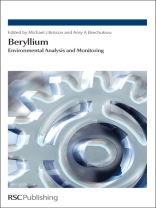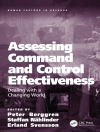As the use of beryllium grows worldwide, the need for a single source of information on this important but toxic element is of increasing importance. This comprehensive book describes all aspects of the current sampling and analysis techniques for trace-level beryllium in the workplace. It offers both a historical perspective and a description of the state-of-the-art in a single place. It covers the challenges inherent in sampling procedures such as reproducibility, limited sample volume, surface sampling materials and collection efficiency. It also deals with the problems involved in analytical techniques including lower detection limits, identification and compensation for matrix interferences, greater sensitivity requirements and the need for more robust preparation techniques. Future trends, including development of real-time beryllium sampling and analysis equipment, are also explored. Readers will gain an understanding of sampling and analytical techniques best suited for sensitive and accurate analysis of beryllium at ultra-trace levels in environmental and workplace samples. Many ‘standard’ sampling and analysis techniques have weaknesses that this book will help users avoid. Written by recognized experts in the field, the book provides a single point of reference for professionals in analytical chemistry, industrial hygiene, and environmental science.
Tabela de Conteúdo
Introduction: Purpose or Background; Methods; Summary. Chapter 1: Overview of Beryllium Sampling and Analysis. Introduction; Background; Beryllium Sources; Industrial Uses; Health Risks; Natural Versus Anthropogenic; Carcinogenicity; Acute Beryllium Disease; Chronic Beryllium Disease; Occupational Exposure Limits; History; Current Limits; Trends; Impact of U.S. Department of Energy Beryllium Rule; Environmental Remediation; Sampling Overview; Air Sampling; Surface Sampling; Dermal Sampling; Soil Sampling; Analysis Overview: Summary of Current Techniques; Need for Improved Performance; Need for Real-Time Monitoring; Goals of This Book (Summary). Chapter 2: Air Sampling. Introduction; Purpose of Air Sampling and Choice of Strategy; Sampling for Compliance with a Limit Value; Sampling to Determine the Effectiveness of Control Measures; Sampling to Identify a Group Range of Exposures; Identification of a Homogenous Exposure Group (HEG); Determining the Range of Exposures of a HEG; Sampling for Prospective Health Studies; Methods of Air Sampling; Properties and Behaviors of Aerosols; Sources of Beryllium Aerosols; Sampling for Non-volatile Aerosols Using Filters; Size-selective Sampling; Inhalable Sampling; Respirable Sampling; High-volume Sampling; Sampling for Volatile Aerosols; Sampling for Ultrafine Aerosols; Metrics for Ultrafine Particles; Analytical Considerations for Selecting a Sampling Method; Retrospective Exposure Assessments; Determining a Job-exposure Matrix (JEM); Cumulative vs Peak Exposures in Assessing Exposure Histories; Summary. Chapter 3: Successful Surface Sampling for Beryllium. Introduction; Background; Wipe Sampling – Dry, Wet, Alcohol; Bulk Sampling – Sweep, Vacuum, HEPA Sock; Methods; Sampling Safety; Planning Meetings – Before and During Sampling Campaigns; Communication; Personal Factors; Personal Protection Equipment (PPE); Protecting the Sampler; Protecting the Sample; Sample Planning – Avoiding Surprises and Delays; Getting Organized – The Plan – Large or Small; Sampling Campaign Type, Scope and Strategy; Detailed Sampling Plan and Agreement to Follow; Sampling Safety Plan Included; Include Site History in Plan; Possible Interferences Identified; Time Line & Locations of Beryllium Work; Time Line & Locations of Interferences Work; Beryllium in Naturally Occurring Materials; Recordkeeping; Chain-Of-Custody; Oversight – Method – Assignments – Reports – Forms; Locations of Sample Points and Number of Samples – How Determined; Random Selection Sample Points; Biased Sample Points; Sampling Techniques and Requirements Detailed; Photography Requirements and Permits; Analysis of Samples – Pre-Qualifying and Selection of the Laboratory; Quality Control Measures; Data Reduction Format; Final Report Parameters; Cost Considerations – What is Desired vs. What is Needed; Sampling Supplies; Consumables; Hand Tools; Power Equipment, Cords and Work Carts; Sampling Team Needs – Lunches and Other Logistics; Trash and Waste Collection and Disposal; Surface Sampling – When To Do What and Why; Regulatory Requirements for Sampling; Sampling Methods; Surface Clean, Dusty or Dirty; Wipe vs. Bulk; Dry Wipe vs. Wet Wipe vs. Alcohol Wipe; Bulk Sampling; Determining Surface Area; Recordkeeping and Photography; Protection of Sample Process and Samples from Contamination; Obtaining the Sample; Sampling for Release of Items from Radiologically Contaminated Areas; Summary. Chapter 4: Sample Dissolution Reagents for Beryllium. Introduction: Background; Methods of Sample Preparation in Geological Media; Beryllium Ores; Soils and Silicates; Methods of Sample Preparation for Occupational Hygiene Samples; Workplace Air Samples; Surface Samples; Bulk Samples; Summary. Chapter 5: Heating Sources for Beryllium Sample Preparation. Introduction; Purpose of Heating; Kinetics of Dissolution; Issues with Particulates; Issues with Speciation; Methods; Mechanical Agitation; Limitations/Requirements; Advantages; Examples (Soils); Thermal Heating; Limitations/Requirements; Advantages; Examples (Ashing, Hot Acid, Hot Ammoniumbifluoride); Sonication; Limitations/Requirements; Advantages; Examples; Microwave; Limitations/Requirements; Advantages; Examples (Combine with Acid for ICP); Selected Comparisons; Filters; Comparison of Heating Methods on Recovery for Ammonium Bifluoride Dissolution; Soils; Summary. Chapter 6: Inductively Coupled Plasma Atomic Emission Spectrometry And Inductively Coupled Plasma Mass Spectrometry. Introduction; Background; Concept of ICP analysis and AES and MS detection; Methods – Preparation of Samples; Methods Available; Analytical Considerations for Selecting a Sample Preparation Method; Challenges with Beryllium Samples for Analysis by ICP-AES or ICP-MS; Quality Control/Quality Assurance; Methods – Analysis by ICP-AES; Instrumentation (tentative); Selection of Line (Intensity, Detection Limit); Interferences (Background, Spectral, Suppression); Need to Know Other Constituents; How to Correct (Different Wavelength, Correction Factor); Sensitivity; Matrix Effects; Analytical Methods; Considerations when Working with Beryllium; Methods – Analysis by ICP/MS; Instrumentation; The Mass Spectrum; Interferences; Sensitivity; Matrix Effects; Analytical Methods; Considerations when Working with Beryllium; Tables/Charts: Summary of Prep Methods; Spectrum with Example of Potential Interferences. Summary. Chapter 7: Analysis by Non-Plasma Sources. Introduction; Background; Methods; Atomic Absorption; Methodology; Detection Limits; Interferences and Limitations; Applications; UV-Visible; Methodology; Detection Limits; Interferences and Limitations; Applications; Fluorescence; Methodology; Detection Limits; Interferences and Limitations; Applications; Electrochemistry; Methodology; Detection Limits; Interferences and Limitations; Applications; Laser Induced Breakdown Spectroscopy (LIBS); Methodology; Detection Limits; Interferences and Limitations; Applications; Summary. Chapter 8: Data Reporting & Communications. Introduction; Background; Terminology; Data Censoring; Challenges in Evaluating Censored Data; Other Fundamental Concepts; Methods; Evaluation Based on Individual Data Points; Laboratory Reporting Limits; Basis, Pros and Cons; Evaluation Based on Data Sets; Data/Measurement Quality Objectives; Basis, Pros and Cons; Uncensored Data; What It Is; When It May Be Useful; When Not to Use It; Considerations for Laboratories and Clients; Project Planning; Laboratory Integration in Project Design Decisions; Quality Control; Quality Assurance; Beryllium Data Reporting; Preparation (Before Analysis); Instrumentation; Qualities of Reported Data; Quantitation as a Substitute for Uncertainty Reporting; Communicating Results; Laboratory to Client; Data Evaluation; Communication to Managers and Stakeholders; Summary. Chapter 9: Applications, Future Trends, and Opportunities. Applications of Current Technologies; Uses of Analytical Measurements; Diagnostic Sampling; Exposure Assessment; Exposure Surveillance; Data Evaluation; Data Quality Objectives; Data Sets Versus Data Points; Precision/Bias Versus Uncertainty Budgets; Future Trends and Opportunities; Drivers for Change; Occupational Exposure Limits; Real-Time Monitoring; Size-Selective Sampling; Technology Improvements; Sampling; Analysis; Data Evaluation; Exposure; Assessment Strategies; Summary.
Sobre o autor
Michael J. Brisson has over 30 years experience in analytical chemistry specializing in spectroscopy. His current work includes advisory support for industrial hygiene laboratories handling radioactive samples, and for the design of new nuclear laboratories. He is currently Chair of the Beryllium Health and Safety Committee (U.S. Departments of Energy and Defence) and Secretary of the ASTM International Committee on Air Quality. He is also the technical lead for three ASTM International Standards. He has organized numerous beryllium-related technical sessions at the American Chemical Society and the American Industrial Hygiene Association national meetings and was lead organizer of the Second Symposium on Beryllium Particulates and Their Detection in Salt Lake City, November 2005. He is author or co-author of eight peer-reviewed journal articles and guest edited a special issue of the Journal of Environmental Monitoring on beryllium sampling and analysis. Amy A. Ekechukwu is a senior Fellow Scientist with over 26 years experience in spectrophotometry, chromatography, electrochemical analysis and synthesis, liquid scintillation counting, gamma spectrophotometry, handling of radioactive material, and a variety of wet chemistry methods. She was profiled as International Woman of the Month for Women in Technology International, June 2000 and is currently a member of the Executive Board of the Beryllium Health and Safety Committee (U.S. Departments of Energy and Defence). She has chaired prominent sessions at four International Ion Chromatography Forums, organized numerous sessions at the American Chemical Society and the American Industrial Hygiene Association national meetings. She was lead organizer for the Third International Symposium on Beryllium Particulates and Their Detection in November 2008 in Albuquerque and has had eleven patents granted.












